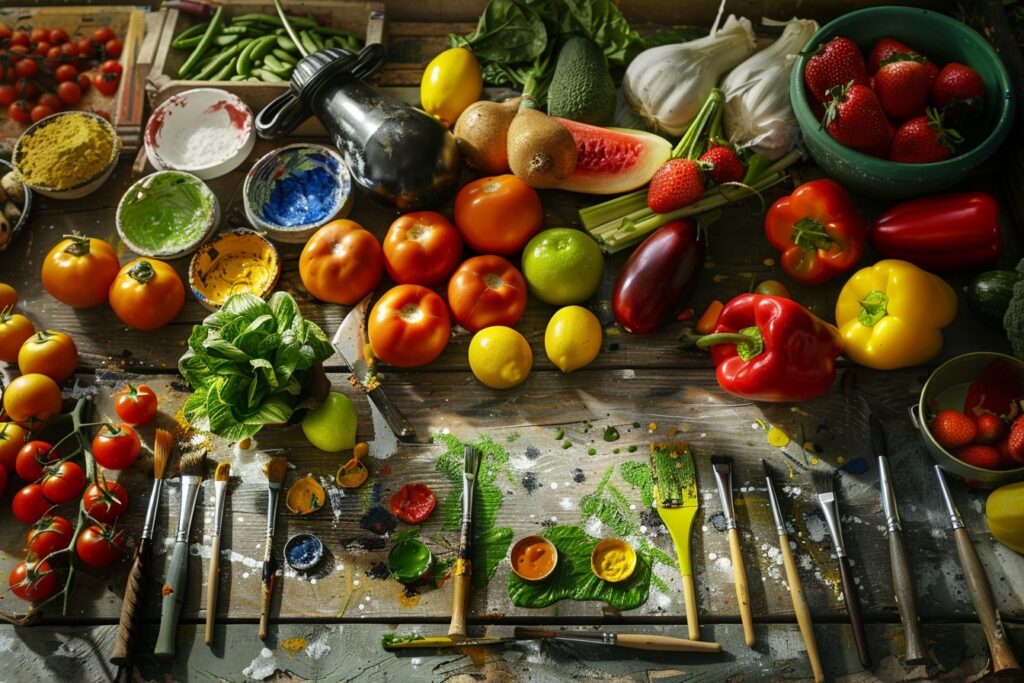Table of Contents
ToggleExploring Edible Art: Fruit and Veggie Stamping
Have you ever wondered how to turn your kitchen into a vibrant art studio, where creativity flows as freely as the colors of the rainbow? Picture this: crisp apples transformed into elegant rose patterns, vibrant bell peppers leaving intricate mandala imprints, and juicy watermelons offering up their refreshing essence to adorn blank canvases. This is the magical world of fruit and veggie stamping.
As parents, we are constantly seeking ways to engage our children in activities that are not only fun but also educational and enriching. Fruit and veggie stamping presents a delightful fusion of art and nutrition, allowing us to explore our creativity while celebrating the beauty and versatility of nature’s bounty.
But why stop at simply creating art when we can also nourish our bodies and souls in the process? That’s the beauty of edible art – it tantalizes our taste buds while igniting our imaginations, offering a feast for both the eyes and the senses.
For me, fruit and veggie stamping is more than just a creative outlet; it’s a journey of discovery and connection with my children. I’ll never forget the sheer delight on their faces the first time we dipped slices of ripe mango into vibrant paint and pressed them onto sheets of paper, creating tropical-inspired masterpieces that captured the essence of our Caribbean heritage.
There’s something profoundly satisfying about transforming humble fruits and vegetables into works of art, each stamp bearing the imprint of nature’s beauty and our own creativity. It’s a reminder that art is not confined to galleries or museums; it’s all around us, waiting to be discovered and celebrated in the simplest of everyday moments.
Throughout this article, we’ll delve deeper into the enchanting world of fruit and veggie stamping, exploring the endless possibilities and inspirations it offers. From selecting the perfect produce to unleashing our imaginations on the canvas, we’ll embark on a colorful journey of creativity, culture, and culinary delights.
So, grab your aprons and prepare to embark on a deliciously creative adventure. Let’s explore the artistry of edible art and discover the joy of fruit and veggie stamping together!
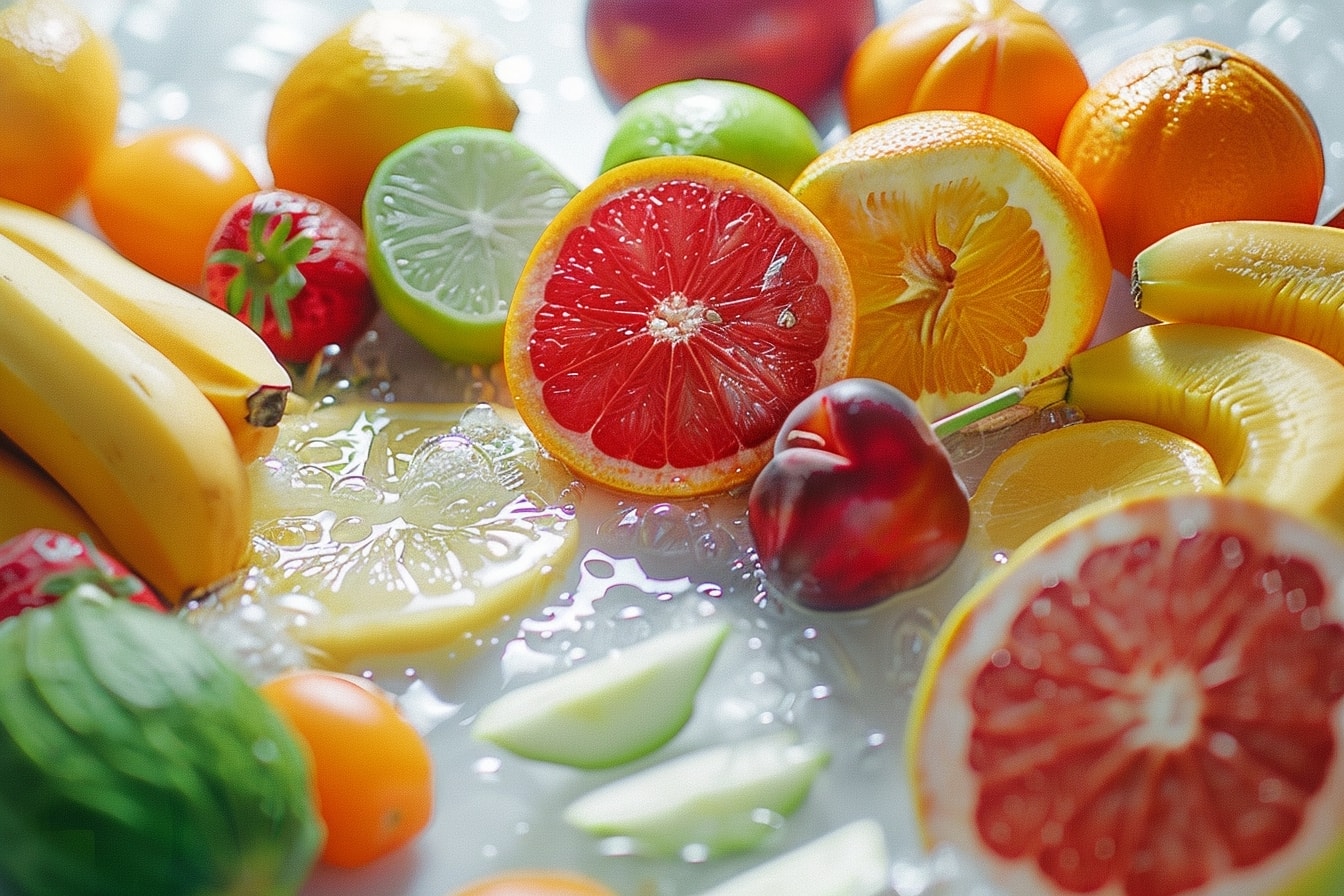
Unleashing Creativity with Nature’s Canvas
Let’s dive into the heart of edible artistry – the exhilarating process of transforming nature’s bounty into vibrant works of creativity. When it comes to fruit and veggie stamping, the possibilities are as endless as the colors of the Caribbean sea.
First things first: selecting the perfect produce for your stamping endeavors. As any seasoned artist knows, the quality of your materials can make all the difference. When choosing fruits and vegetables for stamping, opt for ones that are firm and fresh, with smooth surfaces that will yield clear impressions. Think crisp apples, firm bell peppers, and sturdy potatoes – each offering its own unique texture and pattern to play with.
- Apples: Choose a variety of apple with a firm texture, such as Granny Smith or Fuji. Slice the apple horizontally to reveal the natural star-shaped core, perfect for creating whimsical patterns.
- Bell Peppers: Select peppers with smooth, unblemished skins in vibrant hues like red, yellow, and green. Cut them into halves or quarters to reveal their intricate seed patterns, ideal for creating bold and graphic designs.
- Potatoes: Opt for medium-sized potatoes with smooth, evenly-shaped surfaces. Cut them into slices or shapes using cookie cutters to create custom stamps with endless possibilities.
Once you’ve gathered your produce, it’s time to prepare them for their starring role on the artistic stage. Wash them thoroughly under cold water to remove any dirt or residue, then pat them dry with a clean kitchen towel. For fruits like apples or pears, you may want to slice them into even thicknesses to ensure uniform stamping results. Experiment with different cutting techniques to achieve varying effects – from delicate slices to bold imprints.
Now comes the fun part: dipping your produce into a palette of vibrant paints and watching as they come to life on the canvas. Opt for non-toxic, washable paints in an array of colors to unleash your inner artist. Use a brush or sponge to apply the paint evenly onto the surface of your produce, ensuring full coverage for the best stamping results.
As you press your painted produce onto sheets of paper or fabric, let your imagination run wild. Create intricate patterns, whimsical designs, or bold abstract compositions – the choice is yours. Experiment with different combinations of colors, textures, and stamping techniques to discover what inspires you most.
Remember, the beauty of fruit and veggie stamping lies in its simplicity and versatility. Whether you’re crafting handmade cards, decorating gift wrap, or embellishing fabric for DIY projects, the possibilities are limited only by your imagination. So, gather your favorite fruits and vegetables, unleash your creativity, and let nature be your guide on this deliciously artistic journey.
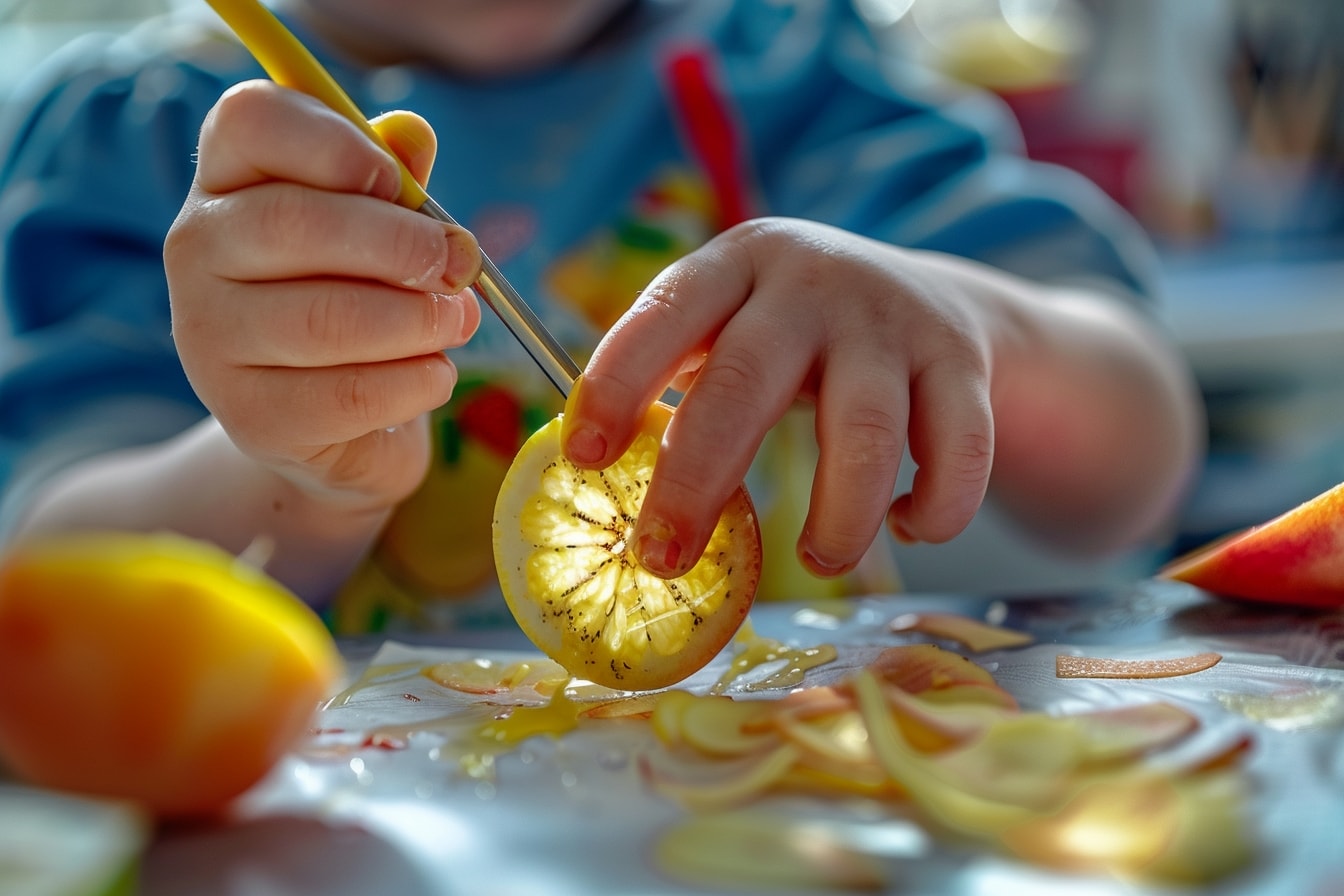
Overcoming Challenges in Edible Art
Embarking on a journey of edible artistry is a thrilling adventure filled with boundless creativity and culinary delights. However, like any artistic pursuit, fruit and veggie stamping can come with its fair share of challenges. Fear not, fellow artists – with a dash of creativity and a sprinkle of perseverance, we can overcome any obstacle that stands in our way.
One common challenge when it comes to fruit and veggie stamping is achieving the perfect paint consistency. Too thin, and the paint may run, resulting in smudged or blurry impressions. Too thick, and the paint may not adhere properly to the produce, leading to uneven or patchy results.
- Solution: Experiment with different paint-to-water ratios until you find the perfect balance. Start with a small amount of water and gradually add more until you reach the desired consistency. Test the paint on a spare piece of paper or fabric before stamping to ensure optimal results.
Another challenge to consider is managing excess moisture, particularly when working with juicy fruits like oranges or strawberries. Excess moisture can cause the paint to slide or smear, compromising the clarity and definition of your stamped impressions.
- Solution: Before stamping, blot excess moisture from the surface of your produce using a clean kitchen towel or paper towel. You can also dust the surface lightly with cornstarch or flour to absorb any remaining moisture and create a dry, tacky surface for the paint to adhere to.
Additionally, achieving consistent pressure when stamping can be tricky, especially for younger children or those new to the craft. Inconsistent pressure can result in uneven or faint impressions, detracting from the overall visual impact of your artwork.
- Solution: Encourage gentle and controlled stamping motions, emphasizing the importance of applying even pressure across the entire surface of the produce. Practice on scrap paper or fabric to develop a feel for the right amount of pressure needed to achieve clear and crisp impressions.
Finally, cleanup can pose its own set of challenges, particularly when working with stubborn stains or delicate materials. Traditional cleaning methods may not be effective or may risk damaging the surface of your stamped creations.
- Solution: For stubborn stains, try soaking the stamped material in a mixture of warm water and mild dish soap before gently scrubbing with a soft brush or sponge. For delicate fabrics, consider spot cleaning with a gentle fabric cleaner or hand-washing in cold water. Always air dry stamped materials to prevent damage or distortion.
By anticipating and addressing these challenges head-on, we can ensure a smooth and enjoyable fruit and veggie stamping experience for artists of all ages. So, roll up your sleeves, embrace the creative process, and let your imagination take flight as you embark on this deliciously artistic journey.
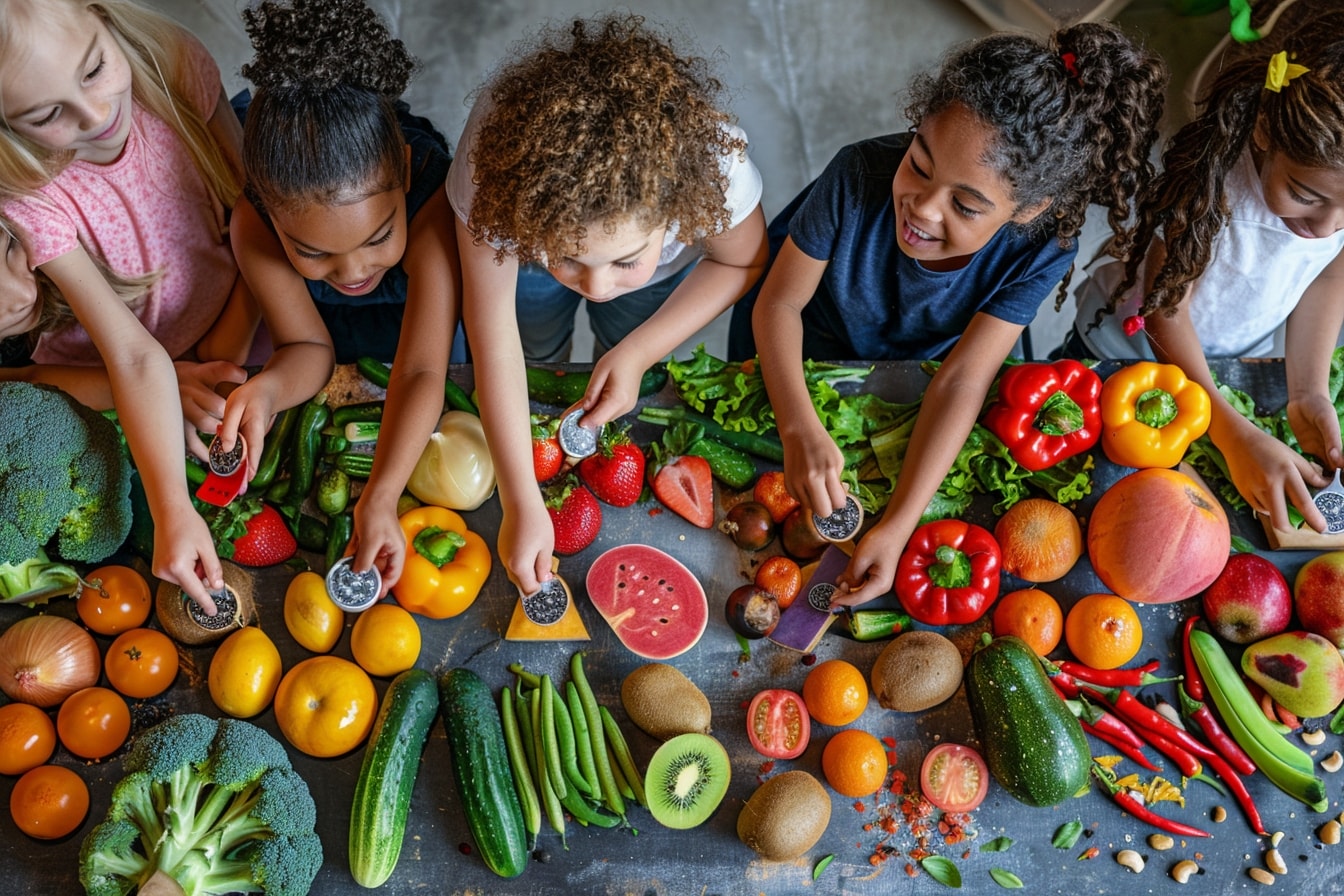
Trends in Healthy Creativity
As parents, we are witnessing a remarkable shift in the way we approach creativity and nutrition in our children’s lives. Gone are the days of mindless screen time and processed snacks; instead, we are embracing a new era of healthy creativity that celebrates the intersection of art, culture, and nutrition.
One of the most exciting trends in this space is the rise of edible art as a fun and interactive way to engage children in healthy eating habits. By incorporating fruits and vegetables into artistic endeavors like stamping, painting, and sculpting, we are not only fostering creativity but also instilling a lifelong appreciation for nutritious foods.
But the appeal of edible art extends far beyond its nutritional benefits. It’s also about celebrating diversity and cultural heritage, honoring the rich tapestry of flavors, colors, and traditions that make up our culinary landscape. In Caribbean culture, food is not just sustenance; it’s a form of expression, a way to connect with our roots and share our stories with the world.
As we explore the world of fruit and veggie stamping, we are not only creating beautiful works of art; we are also celebrating the vibrant flavors and vibrant cultures that inspire us. From the bold flavors of jerk seasoning to the tropical sweetness of mangoes and papayas, Caribbean cuisine is a treasure trove of inspiration for edible artists of all ages.
But it’s not just about the finished product; it’s also about the process – the joy of experimenting with new ingredients, the satisfaction of watching our creations come to life, and the sense of pride that comes from knowing we are nourishing our bodies and souls in the process.
And as we look to the future, the possibilities for healthy creativity are endless. From community gardens and farmers’ markets to cooking classes and culinary workshops, there are countless opportunities to inspire the next generation of edible artists and food enthusiasts.
So, let’s embrace this exciting trend in healthy creativity and embark on a deliciously artistic journey that nourishes both body and soul. Together, we can celebrate the beauty of fruits and vegetables, honor our cultural heritage, and inspire a new generation of creative and healthy eaters.
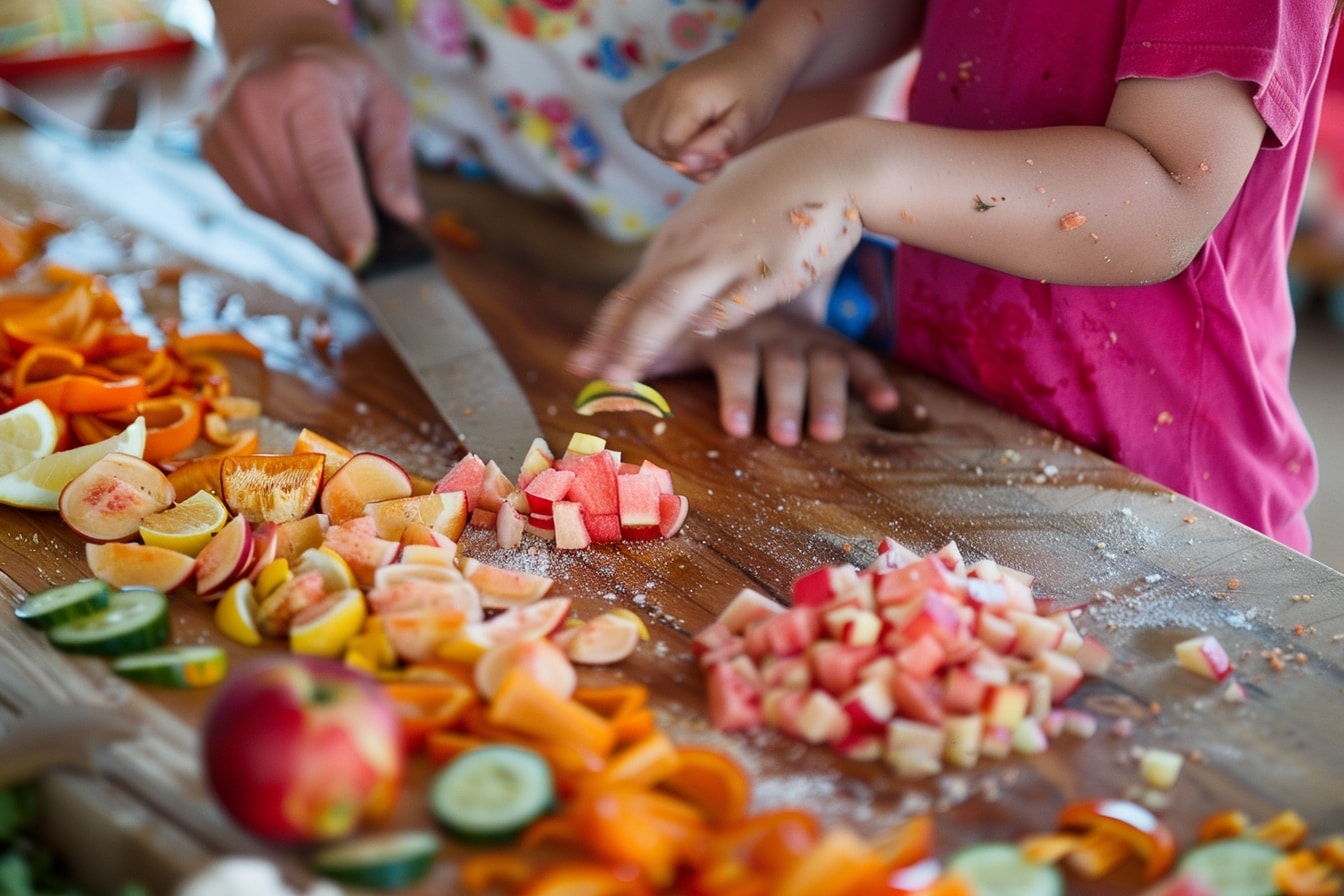
Bringing Edible Art to Life: Step-by-Step Guide
Are you ready to embark on a deliciously creative adventure? Let’s dive into the step-by-step process of bringing edible art to life through fruit and veggie stamping. From preparation to execution, we’ll explore the ins and outs of this delightful craft, ensuring a fun and rewarding experience for artists of all ages.
Step 1: Gather Your Materials
- Assorted fruits and vegetables (e.g., apples, bell peppers, potatoes)
- Non-toxic, washable paints in an array of colors
- Paintbrushes or sponges for applying paint
- Paper or fabric for stamping
- Cutting board and knife for preparing produce
- Aprons or smocks to protect clothing
Before diving into the creative process, take a moment to gather all the necessary materials. Choose a variety of fruits and vegetables with interesting textures and shapes, ensuring they are fresh and firm for optimal stamping results. Select non-toxic paints in vibrant colors that will bring your creations to life on the canvas.
Step 2: Prepare Your Produce
- Wash fruits and vegetables under cold water to remove dirt and residue
- Pat dry with a clean kitchen towel or paper towel
- Cut produce into slices, shapes, or halves as desired
Once you’ve gathered your materials, it’s time to prepare your produce for stamping. Thoroughly wash fruits and vegetables under cold water to ensure they are clean and free from any contaminants. Use a clean kitchen towel or paper towel to pat them dry, removing excess moisture that may interfere with the stamping process. Cut produce into slices, shapes, or halves using a knife or cookie cutters, experimenting with different sizes and designs.
Step 3: Apply Paint to Produce
- Pour a small amount of paint onto a palette or shallow dish
- Use a paintbrush or sponge to apply paint evenly onto the surface of your produce
- Ensure full coverage for the best stamping results
Now it’s time to add some color to your creations! Pour a small amount of paint onto a palette or shallow dish, selecting colors that inspire you and complement your chosen produce. Use a paintbrush or sponge to apply paint evenly onto the surface of your produce, ensuring full coverage for the best stamping results. Get creative with your color combinations, mixing and blending hues to create unique and vibrant designs.
Step 4: Stamp Your Creations
- Press painted produce firmly onto paper or fabric to create stamped impressions
- Experiment with different stamping techniques and patterns
- Allow stamped creations to dry completely before handling or displaying
Now for the moment of truth – it’s time to stamp your creations onto paper or fabric and watch as they come to life! Press painted produce firmly onto the surface, applying even pressure to ensure clear and crisp impressions. Experiment with different stamping techniques and patterns, from simple geometric shapes to intricate designs inspired by nature. Allow stamped creations to dry completely before handling or displaying, ensuring the paint has fully set and won’t smudge.
Step 5: Clean Up and Enjoy!
- Wash painted produce under cold water to remove excess paint
- Clean brushes or sponges with soap and water
- Store stamped creations in a safe place to preserve their beauty
Congratulations – you’ve successfully brought your edible art to life! Now it’s time to clean up and enjoy the fruits of your labor. Wash painted produce under cold water to remove excess paint, ensuring they are safe to eat or use in future projects. Clean brushes or sponges with soap and water, removing any lingering paint residue. Store stamped creations in a safe place to preserve their beauty and cherish the memories of your creative adventure.
With this step-by-step guide, you’re well-equipped to unleash your creativity and explore the enchanting world of fruit and veggie stamping. So gather your materials, set aside some time for artistic exploration, and let your imagination take flight as you embark on this deliciously creative journey!
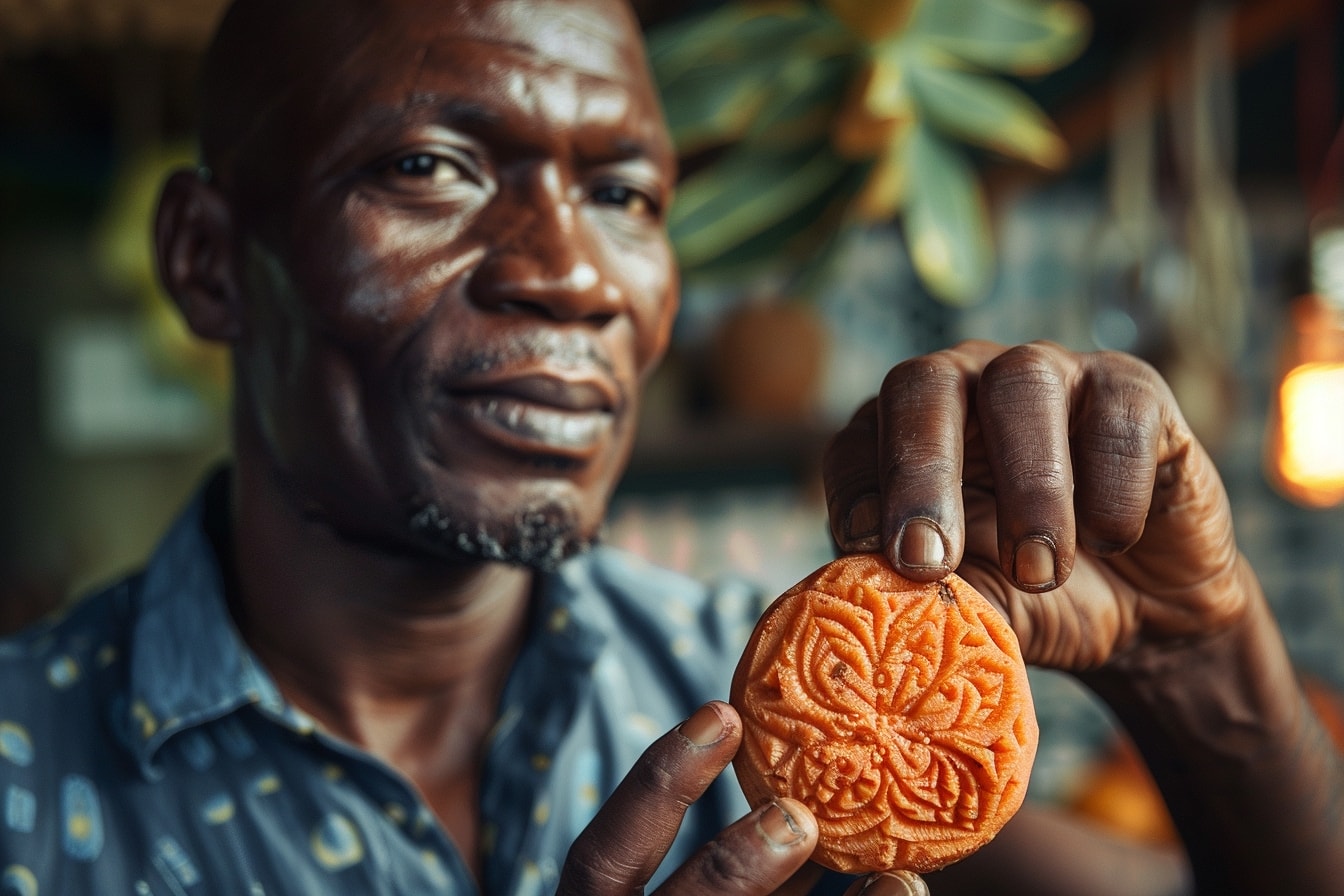
Expert Insights and Reflections
What better way to gain inspiration and wisdom than from the experts themselves? In this section, we’ll delve into the insights and reflections of renowned artists, chefs, and educators who specialize in the captivating world of edible art. Through their expertise and experiences, we’ll gain valuable perspectives on the transformative power of creativity, culture, and nutrition.
Interview with Chef Miguel Sanchez
As a master chef with a passion for both culinary artistry and creative expression, Chef Miguel Sanchez brings a unique perspective to the world of edible art. For Chef Miguel, food is not just fuel for the body; it’s a canvas for storytelling, a medium for cultural exchange, and a source of joy and inspiration for people of all ages.
- On the Intersection of Food and Art: Food has the remarkable ability to transcend cultural boundaries and evoke powerful emotions. By combining elements of color, texture, and flavor, we can create truly unforgettable dining experiences that delight the senses and nourish the soul.
- On the Importance of Cultural Heritage: As a chef of Caribbean descent, I draw inspiration from my cultural roots to infuse my creations with vibrant flavors and rich storytelling. Through food, we can celebrate diversity, honor tradition, and foster a deeper appreciation for the cultural tapestry that unites us all.
- On the Joy of Creative Expression: For me, edible art is about more than just aesthetics; it’s about connecting with others, sparking conversations, and creating lasting memories. Whether I’m crafting intricate sugar sculptures or designing whimsical fruit displays, I’m constantly amazed by the power of food to bring people together and ignite their imaginations.
Reflections from Artist Sofia Rodriguez
As a visual artist specializing in mixed media and collage, Sofia Rodriguez brings a fresh perspective to the world of edible art. For Sofia, creativity knows no bounds, and the kitchen is just another canvas waiting to be transformed into a masterpiece. Through her innovative approach to food and art, she invites others to see the beauty and potential in everyday ingredients.
- On the Art of Experimentation: In my work, I’m constantly experimenting with new materials and techniques, pushing the boundaries of what is possible. When it comes to edible art, the kitchen becomes my playground, and fruits and vegetables are my paintbrushes. I love exploring the unexpected connections between food and art, finding beauty in the ordinary and inspiration in the mundane.
- On the Power of Playfulness: There’s a sense of joy and playfulness that comes with working with edible materials. Whether I’m arranging sliced fruits into intricate patterns or painting with vegetable dyes, there’s a childlike wonder that infuses every creation. Edible art reminds us to embrace our creativity, to take risks, and to find beauty in imperfection.
- On the Intersection of Art and Nourishment: Food is not just sustenance; it’s a source of nourishment for both the body and the soul. Through edible art, we have the opportunity to nourish ourselves in more ways than one – feeding our hunger for beauty, for connection, and for creative expression. It’s a reminder that art is all around us, waiting to be savored and shared with those we love.
Through the insights and reflections of Chef Miguel Sanchez and Artist Sofia Rodriguez, we gain a deeper appreciation for the transformative power of edible art. From celebrating cultural heritage to embracing the joy of creative expression, their words inspire us to see the world through a new lens – one where food becomes art, and art becomes nourishment for the soul.
As we come to the end of our journey through the enchanting world of fruit and veggie stamping, let us take a moment to reflect on the colorful tapestry of creativity, culture, and nourishment we have woven together. From the humble beginnings of selecting the perfect produce to the joyous culmination of stamping our creations onto paper or fabric, each step has been a celebration of the beauty and abundance that surrounds us.
Throughout this article, we’ve explored the myriad ways in which edible art can enrich our lives – from fostering creativity and connection with our children to honoring cultural heritage and promoting healthy eating habits. We’ve seen how a simple slice of apple or a crisp bell pepper can become a vessel for self-expression, a canvas for storytelling, and a source of joy and inspiration for artists of all ages.
But perhaps the most profound lesson we’ve learned is that art knows no bounds – it transcends language, culture, and age, uniting us in a shared experience of beauty and wonder. Whether we’re stamping intricate patterns onto paper, sculpting playful shapes out of clay, or arranging colorful fruits into vibrant displays, we are all artists, capable of creating beauty and meaning in our own unique way.
So, as we bid farewell to this creative odyssey, let us carry the spirit of edible art with us wherever we go – in our kitchens, our classrooms, and our communities. Let us continue to explore, experiment, and embrace the joy of creative expression, knowing that the possibilities are as endless as our imaginations.
And as we look to the future, let us remember the words of Chef Miguel Sanchez and Artist Sofia Rodriguez – that food is not just fuel for the body; it’s a source of nourishment for the soul. Through edible art, we have the power to nourish ourselves in more ways than one – feeding our hunger for beauty, for connection, and for creative expression.
So, let us raise our paintbrushes and our spatulas in a toast to the transformative power of edible art. May we continue to savor the beauty of fruits and vegetables, honor our cultural heritage, and inspire a new generation of creative and healthy eaters. And may our journey through the world of edible art be just the beginning of a lifelong adventure filled with color, flavor, and endless possibilities.
Want to take your knowledge to the next level? Check out these must-read articles:
- Observe and Explore: Backyard Bug Safari for Toddlers
- Yarn Maze Madness: Fine Motor Skills Challenge
Organize your baby’s wardrobe with our baby clothes closet organizer products! Our organizers are designed specifically for baby clothes. Get your baby’s clothes neat and tidy with our selection of organizers – shop now!
Step into Sue Brown's World of Baby Care, where you'll find a treasure trove of knowledge and wisdom waiting to be explored. Sue's dedication to providing accurate and up-to-date information on baby care shines through in every article, blog post, and resource she shares. From newborn essentials to sleep training tips, breastfeeding advice to nurturing your baby's development, Sue covers a wide range of topics that are essential for every parent to know. Her warm and compassionate approach creates a sense of community and reassurance, making her website a safe haven for parents seeking guidance and support. Let Sue Brown be your partner in this beautiful journey of parenthood, as she empowers you to create a loving, nurturing, and thriving environment for your little one.
- Indoor Air Quality for Infant Respiratory Health - October 20, 2025
- Positive Discipline Foundations: Setting the Stage From Infancy - October 18, 2025
- 2025’s Most Innovative Baby Products Worth the Investment - October 16, 2025

